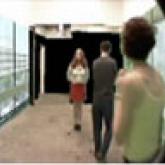Building Paranoia
This exhibition is an example of a show within a show. The Base Kamp artists produced an installation that confronted meaningful and potentially volatile content through the technique of dead-pan dissimulation.
The artists wanted to comment on a situation of poor city planning. The African American Museum of Philadelphia was erected during the bicentennial amidst a flurry of construction that was meant to attract visitors in the summer of ‘76. Much to the chagrin of the museumÕs directors, the new building was allotted the space right next to the Philadelphia police headquarters. In 1997, city planners and local government decided that the empty lot across the street would be the ideal site to construct a Federal Detention Center.
Building Paranoia confronted gallery-goers with tensions between a staged and actual exhibit.
Our staged exhibition was a video which consisted of a gallery installation that presented images of the views from the inside of the African American Museum’s North and South windows. Police Headquarters is prominently in view from the museum’s large northern plate glass window, while the Federal Detention Center floods the opposite window. In the video, gallery visitors interact with one another paying little attention to the images on the walls that surround them. We created the video from footage we gathered by inviting the Philadelphia art community to attend a party in the Project room a week before the actual Building Paranoia opening. The gallery was painted green, and three cameras were set up to record the party-goers’ every move. Through standard green-screen technology, the video appered to document our staged exhibition as if it had actually taken place.
The actual show was a documentary style narrative about our collaborative production of the aforementioned staged exhibition. There was some suspension of disbelief required of visitors, but also a feeling that they had missed a recent show. The running narrative touched on the difficulty of making effective social statements with art, questioned our own roles in relation to racial inequality, and addressed that we were presenting messages to an audience that felt they were already adequately aware of this situation.
Emphasizing the documentation of our own collaborative creation of ‘an exhibition’ (tempered with humor) was our solution to approaching certain structural events without either being too didactic or too defeatist.



